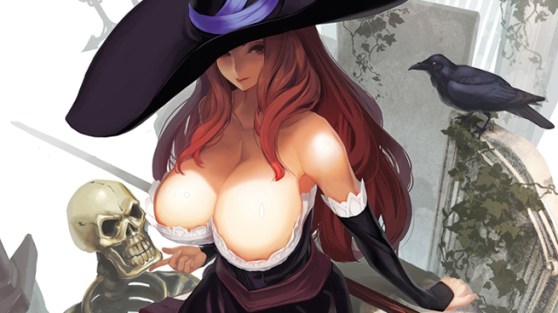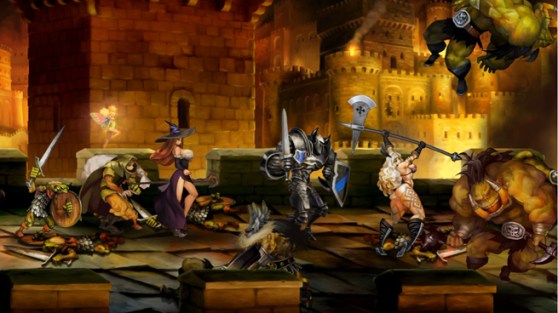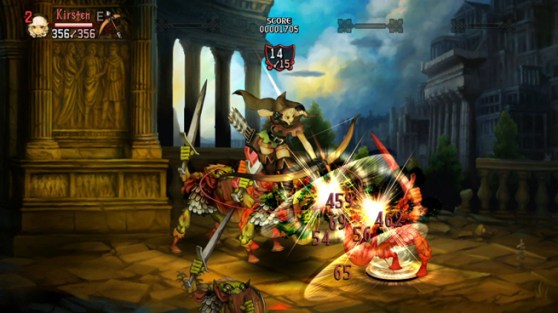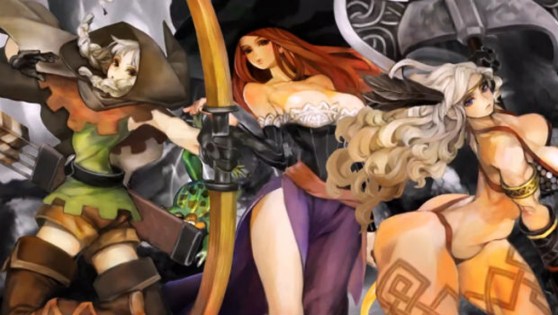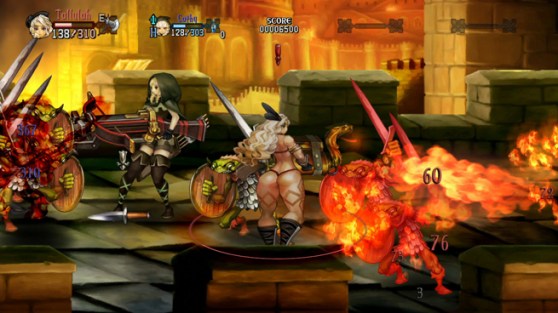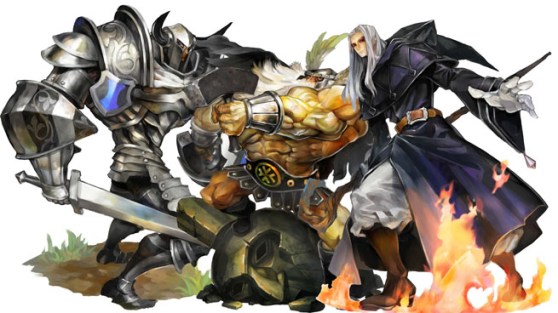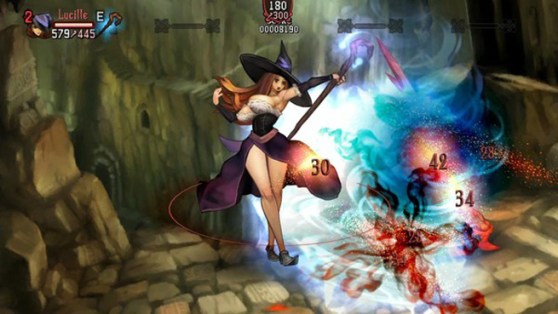Stay on top of all our E3 2013 coverage here.
LOS ANGELES — Sitting behind a row of game journalists hammering through Dragon’s Crown’s four-player co-op at a special pre-E3 event, I kept hearing phrases like “What’s going on?” and “I have no idea what I’m doing.” Jumping on the sticks myself a few minutes later, I experienced a curiously extended sense of What the hell? that lasted my entire playthrough.
And because this is Dragon’s Crown, that feeling didn’t just apply to the gameplay.
The character designs by Vanillaware cofounder George Kamitani (Muramasa: The Demon Blade) drew fire for their hyper-exaggerated style from the second they went public. More specifically, the Amazon and Sorceress characters caused great offense with their (to put it mildly) overtly sexualized designs. At minimum, it shows a fairly big disconnect from the industry’s recent attempts to recognize gender equality issues — a shift some people feel veers too far into overreactive political correctness.
Maybe Dragon’s Crown (due Aug. 6 on PlayStation 3 and PlayStation Vita) simply got caught in that crossfire. I’d love to side-step those issues and evaluate this game based purely on how it plays, but that’s just not possible. It’s not one thing. It’s everything. It’s everywhere. At all times.
Let’s get some basics out of the way. Dragon’s Crown is a 2D, side-scrolling, slash-’em-up where up to four players choose from six character classes — three male, three female (three of which are semiclothed, male and female) — and go adventuring in a lush, high-fantasy world that’s borrowed almost chapter and verse from Dungeons & Dragons. Its secret weapon? A fairly detailed skill upgrade system that lets you trick out your characters to taste, whether that’s a knight who soaks up damage or a ranger who fires three arrows at once.
You also get a few branching paths to go with the role-playing options. A nonplayable Tinkerbell-type fairy and a thief tag along to provide access to bonus areas. Branching pathways give you an option to face the level boss head-on or take a softer approach for less treasure. Hey, we were there to kill us a wyvern, so we charged right in.
Turns out when that boss wyvern isn’t busy raining fireballs down on everybody, it calls in some of its wyvern buddies. We had three dive-bombing us at once. Yeah, I hate wyverns now.
Just don’t ask me how we handled it, because I couldn’t tell you with any accuracy.
Most four-player co-op games feature smallish avatars so everybody can fit comfortably. By comparison, the characters in Dragon’s Crown are huge. A party of four fills up a major chunk of the screen. Then Dragon’s Crown throws a bunch of bugbears and lizard men at them, plus a few giant sabertooth panther mounts players can jump aboard and a ton of blinding “hit” flashes as the fighting commences. And because it’s 2D, they all overlap on top of each other, foreground characters blocking out everyone and everything in the background.
When these guys all scrum together center-screen, bashing away surrounded by Kamitani’s genuinely beautiful art direction, it’s the very definition of a hot mess. Consistently choppy animations didn’t help.
I honestly didn’t know what was going on half the time and had to resort to straight-up button mashing. That bothered me. But not nearly as much as the amped-up, in-your-face sex drive that threatens to make the rest of the game, good or bad, entirely moot.
Kamitani is a highly gifted artist. He makes beautiful games, and Dragon’s Crown is no exception. The man knows what he’s doing.
And he consciously filled this game with blatant sex objects.
Take the Sorceress’ spine-destroying rack and how it jiggles with every move she makes, major or minor. Sometimes, her colossal, physics-defying breasts whipped around so fast I expected them to break her collarbone. I actually spent more time with the Amazon, and while it’s very difficult to offend or shock me with cheap slap-and-tickle, I did start to feel like someone was insulting my intelligence.
For starters, she walks with a hip-dislocating gait designed solely so she can flash her G-stringed ass at the player with every other step. When riding a mount, the Amazon leans back so heavily, I have to figure she’s trying to shift weight off her ample chest. When downed, the Amazon drops on all fours, moaning, in a pose better associated with a hastily made reality-star sex tape. I’m not even joking.
At one point, I wondered to myself, “Does this game want me to fuck it? Because I really don’t want to. It’s not my type.”
No, you don’t have to play as those characters, but the fan service doesn’t stop there. Menu screens feature your fairy girl lounging in a goblet, holding a cherry, and leering at you drunkenly. Still-image cutscenes star women stretched out on sofas wearing see-through dresses.
Now, I hasten to point out that Dragon’s Crown isn’t a parody or a satire — the natural companion of exaggeration. It makes no commentary. This is an homage. It takes itself seriously even though it’s impossible for anyone else to take it seriously. So why do it? Why go in this seemingly exploitative direction?
I put the question to Sammy Matsushima, the project lead for publisher Atlus USA. “It’s not about sexuality,” said Matsushima. “It’s more about exaggeration of fantasy art. This kind of artwork’s been seen in Frank Frazetta-type fantasy art. It’s nothing new.”
Not precisely. Artists like Frazetta and Boris Vallejo painted ridiculously idealized men and women. The style Kamitani chose, for me, veers strongly into the grotesque. I mean that in its literal sense: fanciful human or animal forms distorted into absurdity, ugliness, or caricature. Dragon’s Crown practically demands that I be turned on by these women, and it hard-sells the titillation at every possible turn. I was not titillated. I even felt mildly resentful that it presumed I’d react like a big, dumb guy because I saw big, dumb boobs flopping around.
And that’s the exactly wrong reaction you want someone to have toward a game.
That won’t be everyone’s response. In fairness, Kamitani bent the male characters into funny shapes, too. The Knight looks like a giant silver bullet, the Dwarf is a comical short-stack of muscle, and I caught a wizard named Lucain who’s exactly one lawsuit away from being Gandalf the Grey. A lot of love went into this. Atlus USA, to its credit, chose to back Kamitani up.
“We see his vision, we share his vision, and I don’t think that should be taken away,” says Matsushima. “We’re not going to shy away from it. We should not hide.”
True enough. But while you might find a good game somewhere deep inside Dragon’s Crown, the obstructions are already reason enough for me to give it a miss. The single-player mode feels too lonely, multiplayer too busy, and like Postal 2, I’d feel too much like a drooling idiot if I actually liked what it’s showing me … despite its otherwise outstanding visuals.
“The game is what it is,” as Matsushima says. Odds are you already know if that’s something you want.
VentureBeat's mission is to be a digital town square for technical decision-makers to gain knowledge about transformative enterprise technology and transact. Learn More
